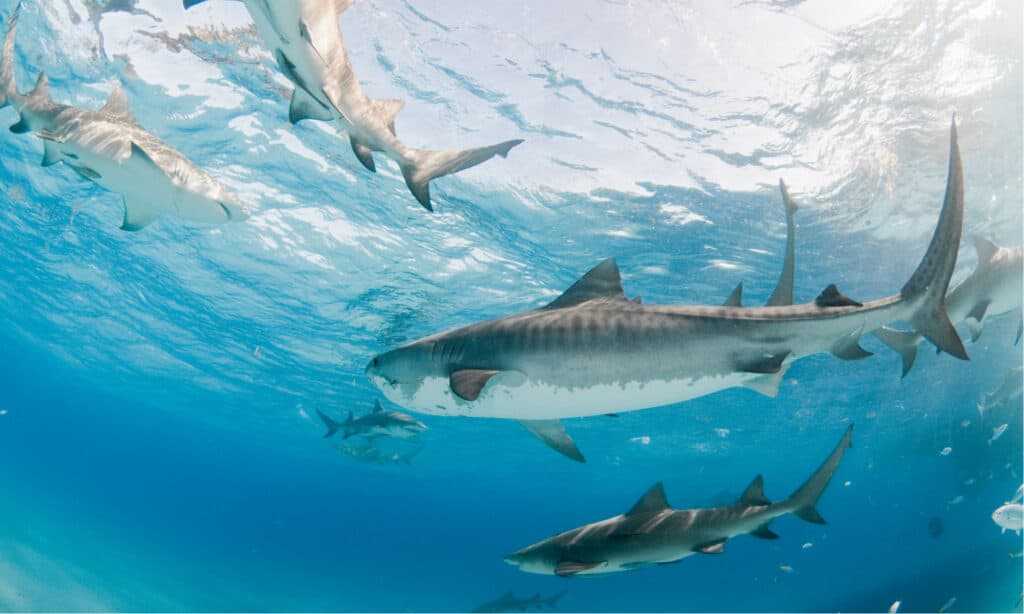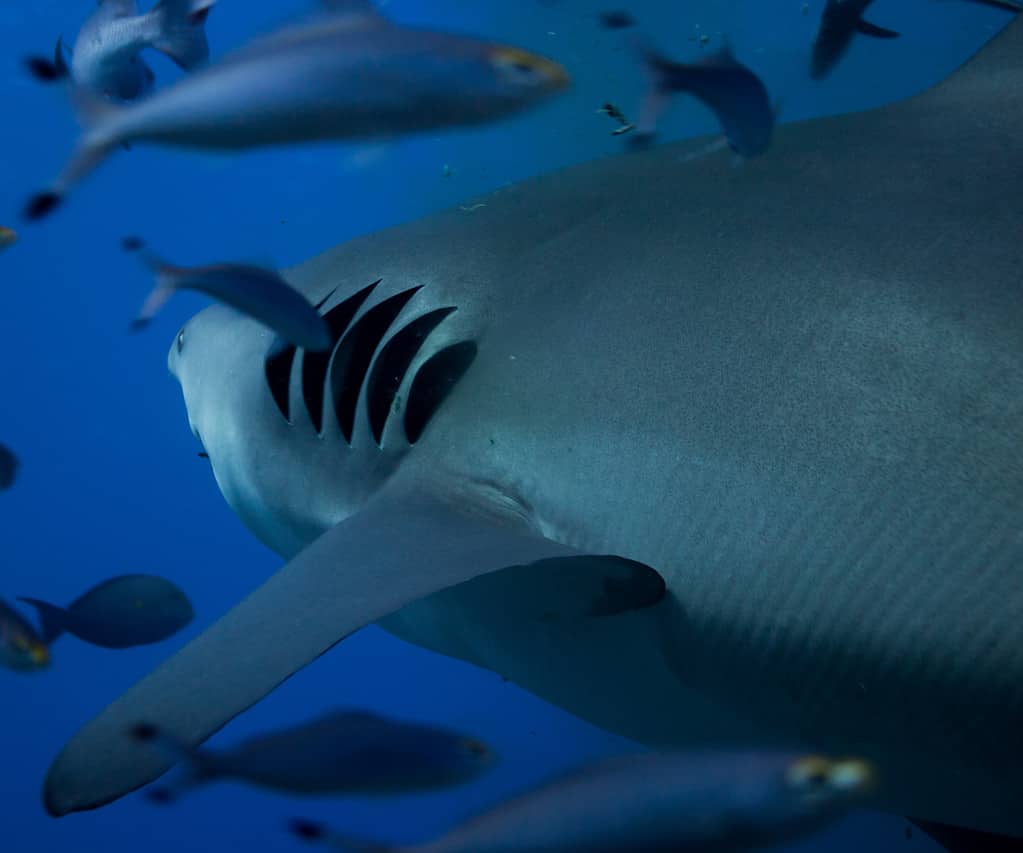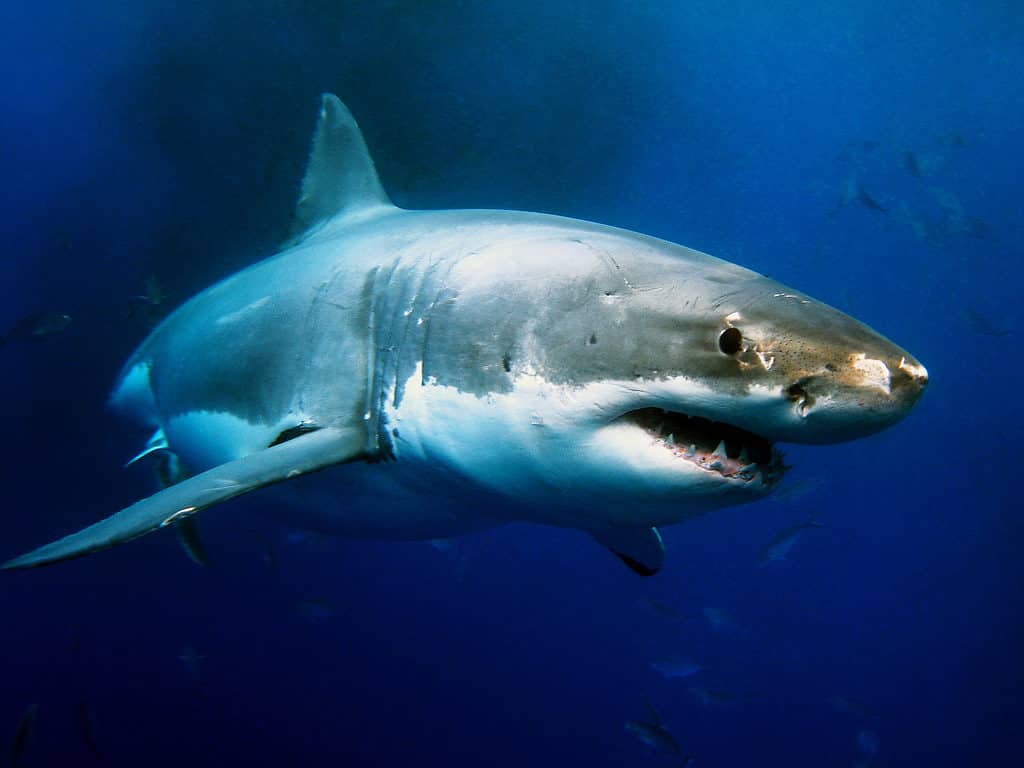Sharks are kings of the ocean and many things about them seem to be mysteries to us. With the majority of the ocean being unexplored by humans, it can be difficult to know just how these creatures survive, thrive, and make the water their home.
With the help of research and experts in the field, we now know more than ever before about sharks and how they use our oceans. Below, we’ll talk all about this and more! If you’re a shark fanatic or just looking to learn something new, keep on reading!

With the help of research and experts in the field, we now know more than ever how sharks use our oceans.
©Fiona Ayerst/Shutterstock.com
Just Keep Swimming
Sharks breathe with the help of their gills, which are breathing tissues analogous to our lungs, just like other fish do. Little blood arteries draw oxygen from the water as it travels over the gill membranes. Via the shark’s gill tissue, carbon dioxide waste also leaves the shark’s body.
But each species of shark has a unique way of pushing water over its gills. There’s an old myth that says sharks must keep swimming in order to breathe. This simply isn’t true for all shark species.
Buccal pumping is a method of breathing used by some sharks, especially those that are not energetic swimmers, such as nurse and bullhead sharks. The buccal (mouth) muscles that continuously suck water into the mouth and over the gills give rise to this technique, which enables sharks to breathe while immobile.
These sharks also feature noticeable spiracles, or apertures for the airways, located behind the eyes, which enable the fish to draw in water even when submerged in sand. Some sharks use ram ventilation, which is when they swim extremely quickly while keeping their mouths open to ventilate their gills. Based on how swiftly they’re swimming, certain sharks, like the tiger shark, can alternate between the two breathing methods.

Sharks have blood arteries which draw oxygen from the water as it travels over their gill membranes.
©iStock.com/Michael Gomes
Using the Space You Have
It seems as if the ocean is limitless, but sharks definitely don’t travel to all areas of the water. Scientists have identified roughly 500 different species of sharks, and more are constantly being discovered.
No two shark species are precisely the same. In oceanography, the term “water column” is used to characterize the temperature, salinity, light transmission and chemical properties of saltwater at various depths.
There are five vertical zones in the ocean and they are:
- Epipelagic
- Mesopelagic
- Bathypelagic
- Abyssopelagic
- Hadalpelagic
It’s relatively well-documented how sharks use the horizontal layers of the ocean, but the vertical zones are something else entirely. Scientists are just starting to skim the surface when it comes to how these creatures use vertical zones.
Thirteen species were discovered by the researchers to have submerged more than .62 miles below the surface. For instance, great white sharks (Carcharodon carcharias) were reported to dive deeper than 0.75 miles, whereas whale sharks (Rhincodon typus) were observed to dive to an astounding 1.17 miles!

Researchers have identified thirteen species of sharks that can dive more than .62 miles below the surface, including the great white shark.
©iStock.com/Whitepointer
How Do Sharks Sleep?
People frequently believe that because they need to move in order to survive, sharks as a species rarely sleep. Sharks do take breaks during the day to relax, but their sleeping patterns are very different from those of other animals.
Their pupils continue to track the movement of the organisms swimming near them, and their eyes stay open at all times. The whitetip reef shark, Caribbean reef shark, nurse shark, wobbegong, and lemon shark are among the sharks that may take a nap when still.
It’s All About Body Language
Sharks congregate in groups known as schools, and they frequently communicate with one another by eyesight or by stretching their bodies. The gray reef shark, which likewise observes its surroundings through an acute sense of smell and a sensitive ear, frequently engages in this type of communication.
For reproduction and locating prey, olfactory communication routes are essential. They take advantage of the amount of time it takes for the smell to travel to each olfactory canal since their nostrils are spaced apart to investigate the source of the fragrance they are able to detect.
As a result of the feeding frenzy, aggressiveness toward other sharks is one of the most prevalent shark communication techniques. During meals, they are more inclined to physically assault than to protect their area. It is known that these animals externalize their hostile intents through their body motions, but less is known about how they communicate in other ways.

Many species, such as gray reef sharks, congregate in schools and communicate with one another by eyesight or by stretching their bodies.
©iStock.com/Marco_Zucchini
How Do Sharks Mate?
Sharks can reproduce in three different ways: viviparity, oviparity, and ovoviviparity. Sharks can occasionally breed asexually, which is a very unusual occurrence.
A shark’s biology and environment have a big impact on how they reproduce. A shark with open ocean experience is more likely to have live young. The likelihood of a shark laying eggs increases as it gets closer to the shore.
Surprisingly, many animals and sharks have comparable reproductive systems.
The term “claspers” refers to the male shark’s reproductive system. For most shark species, it can be located on the pelvic fin. The clasper is really located on the head of the chimeras. Yet, the oviducts are only present in females. The oviduct is essentially a lengthy tube that connects the female’s external body to her womb.
To reproduce, the male will place his clasper inside the female’s oviduct, where he will release sperm to fertilize the eggs. Unlike other animals throughout the world, sharks don’t mount one another. To avoid this, when mating, the two sharks will swim next to each other.
Final Thoughts
There is still so much to learn about these beautiful animals. Thanks to research and experts in the field, we’re learning more and more about how sharks use our oceans. Hopefully, this article taught you something new and helped you learn a thing or two about the kings and queens of the ocean!
The photo featured at the top of this post is © Martin Prochazkacz/Shutterstock.com
Thank you for reading! Have some feedback for us? Contact the AZ Animals editorial team.






